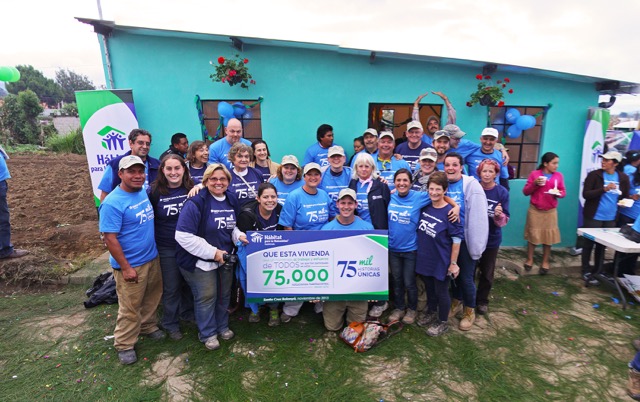WESTFIELD – For three city residents, a Habitat for Humanity project in Guatemala opened their eyes – and hearts – to helping others.
Sue Austin, Margaret O’Connor, and Kim Rexford were among 200 volunteers from across the globe who celebrated a landmark for Habitat for Humanity Guatemala late last year – the 75,000th housing solution project. When the week ended, a special dedication ceremony of the achievement was celebrated by all.
Volunteers, along with Habitat employees and partners, fanned out in teams in and around Tecpan all week, a small city nestled among endless mountains, to build 13 houses, 21 latrines, and 28 smokeless stoves. Days started by rising at 5:15 a.m., eating breakfast at 5:45 (black beans and corn tortillas), and being on the bus by 6:45. Volunteers were back at their camp site around 5 p.m.
On the first day, many groups tackled latrines, dismantling old palettes in an effort to salvage wood and reduce the cost for the latrine owners.
“We tore apart the pallets to get boards for the construction of the latrine,” said Rexford. “For a family that makes $100 a year, any savings is important. We even tried to reuse the nails; however, they were dulled by back hammering them out.”
Austin said constructing the latrines was eye-opening for her.
“Everything is reused and done by hand,” said Austin. “It was incredible to see what was accomplished by such hard-working people.”
As the week progressed, volunteers were also learning the tricks of the trade for building smokeless stoves and homes.
Smokeless stoves are an asset to any home since it helps improve a family’s health by eliminating the smoke that lingers inside the kitchen. Stoves are typically three feet by five feet and use less firewood because of its insulation. Also, the edges are safe to the touch and the hot cooking area is out of reach of children.
Rexford said she worked on every aspect of the stove project.
“From mixing the adobe, to making the bricks, and laying the bricks, it was really neat,” said Rexford.
Rexford explained that there is a “tool” that is used to make the bricks, but only one machine is available for an area of Guatemala.
“The machine is brought to the village and everyone works together to make the bricks for the smokeless stoves, said Rexford. “You fill the form with a clay/sand/pine mixture, and then press the mixture with a lever to make a brick. You then lift the brick out of the machine, balancing it on the plate and you carry it to a place in the sun to dry. Then the process starts again.”
When the time arrived to work on building homes, once again the women were eager to get started. The housing deficit in Guatemala is more than 1.4 million homes.
Habitat Guatemala has been constructing homes for more than 30 years, improving design details so that houses are more sustainable, easier to clean and maintain, and affordable.
Habitat’s model has always used cement block walls, but on the special week of celebration, they introduced a model of housing that uses metal framing with pre-manufactured cement paneling instead of cement blocks. The model is equally priced, but it’s said to be sturdier. A house in Tecpan was symbolically used as “housing solution 75,001” as a test.
“We mixed cement by hand,” said Rexford. “There are no cement trucks that come to the worksite when you are ready for the foundation.”
Rexford said the cement mixture was 10 wheelbarrows of sand and 600 pounds of lime.
“We then mixed this mixture by making piles,” said Rexford. “When mixed, we then added 19 wheelbarrows of trap rock and then water. The mason then mixed it to the correct consistency by adding more of some of the ingredients and put the cement in five-pound buckets to bring to the foundation and it was then poured in.”
O’Connor noted that “bucket brigades” were helpful to move the cement from the mixing location to the foundation.
All women noted that the families receiving the assistance were all appreciative of their efforts.
“This experience was extremely rewarding,” said O’Connor. “The cultural experience the people and the country gave me was a gift.”
O’Connor said that since an early age, she knew she wanted to be a part of a project like Habitat for Humanity.
“I always wanted to do something like this, but life took on its responsibilities with family and employment,” said O’Connor. “So given the chance after retirement, I jumped at the chance. I hope to do it again and I’m thinking of Vietnam.”
Austin echoed those sentiments.
“When the week was over, I didn’t want to come home,” said Austin. “I enjoyed the experience so much. The people we met were so appreciative of our efforts. I am hoping to go back in two years.”
For Rexford, she will always remember her first Habitat build project.
“I have known about Habitat and its mission but was never able to give my time,” said Rexford. “I contributed in other ways, but this for me was an eye opener on how much more I want to give to the organization. I chose to go on the trip because the time was finally right for me.”
Rexford also noted the experience went beyond helping the global community.
“The team had first timers, and folks who have gone to Guatemala several times in a year,” said Rexford. “I knew I could do the work and I would see poverty like I had not seen before. What I did not expect was the outpouring of love, kindness and compassion. You are accepted for who you were. There was equality among everyone.”
Teams of families, friends, and from organizations, as well as individuals, are always sought for the next Habitat International project. For more information, email Whitney White at [email protected] for more details.


